Research Progress
A Valleytronics route towards future reversible computers
Post: 2017-12-20 15:36 View:2304
| Valleytronics is an emerging field exploiting electron's valley degree of freedom for device applications. This novel concept is based on utilizing the wave quantum number of an electron in a crystalline material (read more: "Valleytronics – an alternative electronics concept"). | |||||||||||
| Simply put, 'valleys' are maxima and minima of electron energies in a crystalline solid. Being able to control electrons in different valleys could lead to faster and more efficient computer logic systems and data storage chips. | |||||||||||
| Despite much anticipations of valleytronics as a candidate for ‘beyond CMOS’ technology and as concept to extend Moore's Law, its progress is severely hindered by the lack of practical designs of valleytronic-based information processing unit. | |||||||||||
| "One major challenge in valleytronic-based electronics is the lack of all-electrical-controlled valley filter, a device that produces valley-polarized current via electrical controlling knob and serves as a fundamental building block of valleytronics," Dr. Yee Sin Ang, a Research Fellow at SUTD-MIT International Design Center at Singapore University of Technology and Design, tells Nanowerk. | |||||||||||
| In a paper in Physical Review B ("Valleytronics in merging Dirac cones: All-electric-controlled valley filter, valve, and universal reversible logic gate"), first-authored by Ang, the authors propose a versatile all-electric-controlled valley filter and demonstrate, for the first time, a concrete working design of valleytronic-based logic gate capable of performing all 16 types of Boolean logics. | |||||||||||
| They do this by harnessing the unusual physical properties of two-dimensional (2D) nanomaterials such as few-layer black phosphorus and topological Weyl/Dirac semi-metal thin films, | |||||||||||
|
"Most importantly, this valleytronic-based logic gate can perform logically-reversible computing, which has broad applications including cryptography, signal and image processing, quantum computing, and is ultimately required to improve the energy efficiency of classical computer beyond the Landauer's limit – an irreducible waste-heat generation due to logically-irreversible computation," Ang points out.
|
Address: C508 Dingxin Building, Jilin University, 2699 Qianjin Street, Changchun 130012, P. R. China
Copyright © 2024 International Society of Bionic Engineering All Rights Reserved
吉ICP备11002416号-1
Copyright © 2024 International Society of Bionic Engineering All Rights Reserved
吉ICP备11002416号-1










